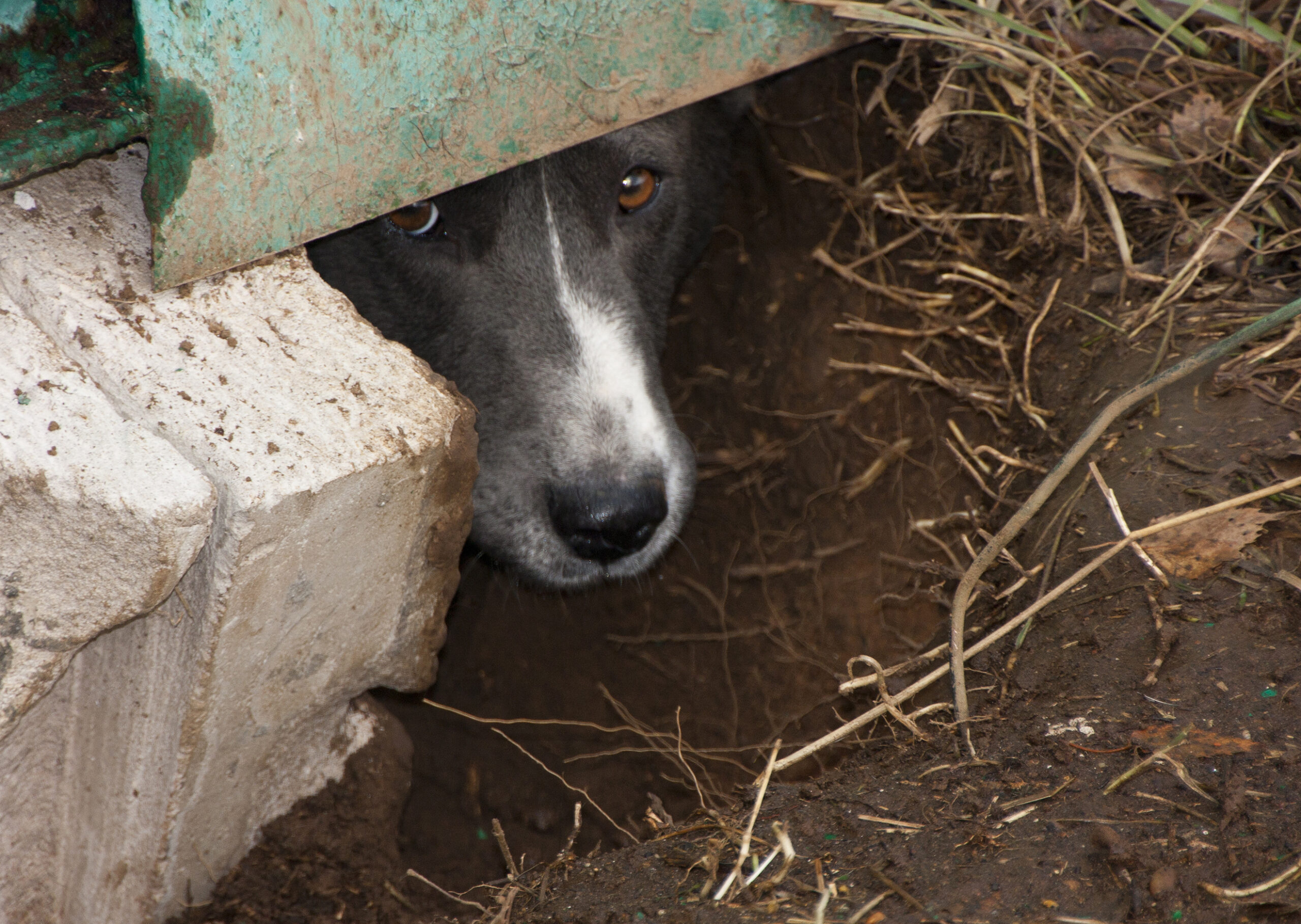Understanding and Treating Dog Separation Anxiety
It can be so hard to deal with a dog that has separation anxiety. They may become destructive, bark excessively, or have accidents in the house when left alone, behaviors that are stressful for both the dog and their owner. If you are reading this, you are probably wondering if it’s treatable, and if so, how? The good news is, dogs that become anxious when left alone, can be treated and in many cases even fully cured!
This post contains some affiliate links, which means that we make a small commission off items you purchase at no additional cost to you.

Introduction: Overview of Dog Separation Anxiety
Dog separation anxiety is a complex, multifaceted issue that affects a significant number of pets worldwide, manifesting in a range of behaviors that can be distressing both for dogs and their owners. At its core, separation anxiety is a condition in which a dog experiences extreme stress and fear when left alone or separated from its primary caretakers.
For new dog owners, recognizing and understanding the nuances of separation anxiety is the first step toward creating a supportive environment that addresses their dog’s unique needs. The impact of separation anxiety extends beyond the immediate emotional distress for the dog; it can lead to behavioral issues that disrupt the household, strain the human-animal bond, and, in severe cases, result in rehoming or abandonment.
As we delve into the causes and symptoms of dog separation anxiety, it’s important to approach this topic with empathy and an open mind. The journey towards mitigating the effects of separation anxiety is often a process of trial and error, requiring patience and understanding. By exploring both the well-documented and lesser-discussed aspects of this condition, we aim to equip dog owners with the knowledge and tools they need to foster a healthier, happier life for their pets.
To Get 20% Off the #1 Vet Recommended CBD Product, Click Here and Use Code: Try20
Part 1: Unraveling the Causes of Dog Separation Anxiety
Understanding the root causes of dog separation anxiety is crucial in developing effective strategies to manage and alleviate its symptoms. This complex condition does not arise from a single factor but is often the result of a combination of genetic, environmental, and psychological components. By examining these underlying causes, dog owners can gain insights into their pets’ behaviors and take proactive steps toward fostering a sense of security and well-being in their dogs.
- Genetic Predisposition and Breed Specificity Certain dog breeds are more prone to experiencing separation anxiety due to their genetic makeup. Breeds such as Border Collies, Labrador Retrievers, German Shepherds, and Australian Shepherds, known for their high intelligence and strong bonds with their owners, can be particularly susceptible. This predisposition suggests that for some dogs, the propensity for separation anxiety is woven into their DNA, influencing their emotional responses to being left alone.
- Early Life Experiences A dog’s experiences during its formative weeks and months can lay the groundwork for future behavioral issues, including separation anxiety. Key factors include:
- Premature separation from the mother and littermates, which can disrupt the natural weaning and socialization process.
- Insufficient exposure to various people, environments, and situations, which can hinder a puppy’s ability to adapt to new experiences.
- Traumatic events or changes in ownership and environment can imprint fear and insecurity, making the dog more prone to anxiety when alone.
- Environmental Changes and Stressors Dogs thrive on routine and predictability. Significant changes in their environment or daily routine can trigger anxiety. These changes might include:
- Moving to a new home.
- Changes in the family dynamic, such as the addition of a new pet or the loss of a family member.
- Alterations in the owner’s schedule, leading to more time spent alone.
- Owner Behavior and Attachment Styles The way owners interact with their dogs can significantly impact the development of separation anxiety. Factors to consider include:
- Over-attachment or lack of independence training, leading dogs to struggle when left alone.
- Inconsistent rules and boundaries, which can create confusion and insecurity.
- Emotional dependency of the owner on the pet, which can reinforce the dog’s anxiety.
Part 2: Recognizing the Symptoms of Dog Separation Anxiety
Recognizing the symptoms of dog separation anxiety is pivotal for early intervention and effective management. These symptoms can vary widely among dogs, reflecting the individual nature of their anxiety. Understanding these signs allows owners to better empathize with their pets and seek appropriate solutions. Below, we delve into the physical, emotional, and behavioral symptoms indicative of separation anxiety, as well as the impact this condition has on both dogs and their owners.
- Physical Signs Physical manifestations of separation anxiety are often the first indicators noticed by owners. These can include:
- Excessive drooling or salivation as soon as the owner prepares to leave.
- Pacing or trembling, indicating a high level of distress.
- Attempts to escape, which can result in self-injury or destruction of property, such as scratching at doors or chewing on barriers.
- Emotional and Behavioral Symptoms Beyond physical signs, dogs with separation anxiety exhibit a range of emotional and behavioral symptoms that reflect their internal struggle. These symptoms include:
- Excessive barking, howling, or whining that occurs in the owner’s absence, often reported by neighbors.
- Destructive behavior targeted at furniture, household items, or personal belongings of the owner, which is not typical of the dog’s behavior when the owner is present.
- Urination and defecation in the house despite being house-trained, particularly near exit points or areas that smell strongly of the owner.

Part 3: Lesser-Known Factors Contributing to Dog Separation Anxiety
While many dog owners are familiar with the common causes and symptoms of separation anxiety, there are several lesser-known factors that can also contribute significantly to this condition. Understanding these overlooked aspects can provide a more comprehensive approach to managing and preventing separation anxiety, offering new perspectives and strategies for those struggling to find solutions.
- Nutritional Imbalances and Behavioral Health The link between diet and behavior in dogs is complex and multifaceted. Nutritional imbalances, such as deficiencies in omega-3 fatty acids, vitamins, and minerals, can adversely affect a dog’s nervous system and brain function, potentially leading to heightened anxiety and stress. Ensuring a well-balanced diet that meets all of their nutritional needs can help stabilize a dog’s mood and reduce anxiety symptoms.
- Changes in Scent in the Home Environment Dogs have an incredibly acute sense of smell, and changes in the home’s scent can impact their sense of security. This could include:
- New cleaning products or air fresheners that mask or alter familiar scents.
- The introduction of new furniture or removal of old items that held the scent of the owner or previous environments.
- Significant changes in the scent of the owner themselves, possibly due to new personal care products, changes in diet, or even emotional stress that can alter an individual’s natural scent.
- Subtle Health Issues or Discomfort Sometimes, what appears to be separation anxiety can be exacerbated or even caused by underlying health issues that make the dog feel more vulnerable or uncomfortable when alone. These issues might include:
- Age-related conditions such as cognitive decline or hearing loss, making them more anxious due to decreased awareness of their surroundings.
- Chronic pain or discomfort from conditions like arthritis, which can make dogs more irritable and less able to cope with stress.
- Sensitivities to noises or environmental factors that become more pronounced in the absence of their primary caregiver.
- Inconsistent Training or Mixed Signals from Owners Dogs thrive on consistency, and mixed signals or inconsistent training can contribute to feelings of anxiety and uncertainty. This may involve:
- Inconsistent responses to the dog’s behavior, such as sometimes punishing separation anxiety behaviors and other times rewarding them with attention.
- Varying routines around leaving and returning home, which can confuse dogs and heighten anxiety over time.
- Lack of clear communication and boundaries, leading to confusion about expected behaviors in the owner’s absence.
- Overstimulation and Lack of Downtime In today’s busy world, dogs often face overstimulation, just like their human counterparts. Factors contributing to this include:
- Frequent visitors or noisy environments that prevent dogs from having quiet, restful periods.
- Lack of structured downtime or safe, quiet spaces where dogs can retreat when feeling overwhelmed.
- Continuous exposure to stimuli, such as television or radio left on for company, which can sometimes have the opposite effect by overstimulating rather than soothing the dog.
Treatments for Dog Separation Anxiety: Integrating Traditional and Innovative Approaches
Managing dog separation anxiety requires a multifaceted approach, combining behavioral strategies, environmental modifications, and, in some cases, medical interventions. Recently, the exploration of CBD (Cannabidiol) and CBDA (Cannabidiolic Acid) as therapeutic options has gained attention in the veterinary community. These compounds, derived from the hemp plant, have shown promise in reducing anxiety and promoting a sense of calm in dogs, without the psychoactive effects associated with THC.
- Behavioral Modification Techniques Behavioral modification plays a pivotal role in treating separation anxiety. Techniques such as desensitization and counterconditioning can help dogs gradually become more comfortable with being alone. This involves slowly introducing the dog to short periods of separation, gradually increasing the duration as the dog becomes more accustomed to the owner’s absence.
- Environmental Enrichment Creating a stimulating environment for your dog can reduce the stress associated with being left alone. This includes providing interactive toys, puzzle feeders, and comfortable resting areas. Such measures can help distract the dog and reduce the anxiety triggered by isolation.
- CBD and CBDA as Emerging Treatments The use of CBD and CBDA for reducing dog separation anxiety has garnered interest due to their potential to alleviate anxiety without significant side effects. A study by ElleVet Sciences highlights the effectiveness of these compounds in managing anxiety and promoting calmness in dogs. According to the study, CBD and CBDA can interact with the endocannabinoid system in dogs, helping to regulate mood and anxiety levels. The research suggests that CBD and CBDA may offer a safe and effective alternative to traditional anxiety medications, with minimal risk of adverse reactions. For those interested in exploring CBD and CBDA as a treatment option, it’s crucial to choose products specifically formulated for pets, ensuring they are of high quality and free from THC. Consulting with a veterinarian before starting any new treatment is essential, as they can provide guidance on appropriate dosing and monitor the dog’s response to the treatment. Read the ElleVet Sciences study on CBD and CBDA for more detailed information.
To Get 20% Off the #1 Vet Recommended CBD Product, Click Here and Use Code: Try20
Treating dog separation anxiety is a journey that requires patience, understanding, and sometimes a bit of trial and error to find what works best for each individual dog. The integration of traditional methods with innovative treatments like CBD and CBDA offers a hopeful path forward for many dogs and their owners. By adopting a holistic approach and working closely with veterinary professionals, dog owners can help their pets lead happier, more relaxed lives.
Conclusion
Dog separation anxiety is a multifaceted condition that affects countless dogs and their owners worldwide. Understanding both the well-known and lesser-known causes of this anxiety is crucial for addressing the issue effectively. From genetic predispositions and early life experiences to environmental changes and subtle health issues, the roots of separation anxiety are diverse and complex.
As we’ve explored, recognizing the symptoms of separation anxiety is the first step towards providing the necessary support your dog needs. Whether it’s through physical signs like excessive drooling and pacing or through behavioral cues like destructive acts and vocalizations, these indicators guide owners in seeking appropriate interventions. Moreover, acknowledging the impact of lesser-known factors, such as changes in the home’s scent, inconsistent training, and even overstimulation, underscores the importance of a holistic approach to managing separation anxiety.
For dog owners navigating the challenges of separation anxiety, the journey towards mitigation is both a science and an art. It requires patience, understanding, and a commitment to exploring various strategies tailored to the individual dog’s needs. This may include behavioral training, environmental adjustments, professional consultation, and sometimes medical intervention.
Ultimately, the goal is to enhance the quality of life for both dogs and their owners, fostering a relationship built on mutual trust and security. By adopting a comprehensive and empathetic approach to understanding and addressing dog separation anxiety, we can create a more harmonious and stress-free environment for our canine companions. Remember, you are not alone in this journey, and with the right tools and support, you can help your dog overcome the challenges of separation anxiety, ensuring a happier, more peaceful coexistence.

